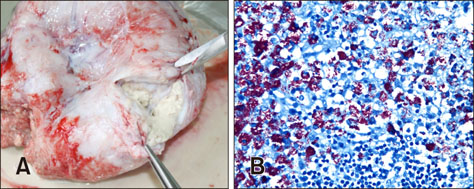J Vet Sci.
2018 Jan;19(1):45-50. 10.4142/jvs.2018.19.1.45.
Investigation of bovine tuberculosis outbreaks by using a trace-back system and molecular typing in Korean Hanwoo beef cattle
- Affiliations
-
- 1Bacterial Disease, Department of Animal and Plant Health Research, Animal and Plant Quarantine Agency, Gimcheon 39660, Korea. kubk@korea.kr
- 2Department of Biomedical Laboratory Science, College of Health Science, Yonsei University, Wonju 26493, Korea. bojeon@yonsei.ac.kr
- 3Foreign Animal Disease, Department of Animal and Plant Health Research, Animal and Plant Quarantine Agency, Gimcheon 39660, Korea.
- 4Namwon Branch, Jeonbuk Livestock & Veterinary Service, Namwon 55725, Korea.
- 5Department of Microbiology, College of Medicine, Yonsei University, Seoul 03722, Korea.
- KMID: 2402694
- DOI: http://doi.org/10.4142/jvs.2018.19.1.45
Abstract
- Bovine tuberculosis is a chronic contagious disease responsible for major agricultural economic losses. Abattoir monitoring and trace-back systems are an appropriate method to control bovine tuberculosis, particularly in beef cattle. In the present study, a trace-back system was applied to bovine tuberculosis cases in Korean native Hanwoo beef cattle. Bovine tuberculosis was detected in three index beef cattle during abattoir monitoring in Jeonbuk Province, Korea, and the original herds were traced back from each index cow. All cattle in each original herd were subjected to tuberculin skin test. The positive rates in the tuberculin skin test were 64.6% (62 of 96), 4.8% (2 of 42), and 8.1% (3 of 37) at farms A, B, and C, respectively. On post-mortem examination of 56 tuberculin-positive cattle, 62% had granulomatous lesions, and Mycobacterium bovis was cultured from 40 (71.4%) of the cattle. Molecular typing by spoligotyping and the mycobacterial interspersed repetitive unit-variable-number tandem repeat assay revealed the genotype of the M. bovis strains from the index cattle were same as the M. bovis genotype in each original herd. The results suggest that tracing back from index cattle to the original herd is an effective method to control bovine tuberculosis in beef cattle.
Keyword
MeSH Terms
Figure
Reference
-
1. Byeon HS, Ji MJ, Kang SS, Kim SW, Kim SC, Park SY, Kim G, Kim J, Cho JE, Ku BK, Kim JM, Jeon BY. Performance of the SD Bioline TB Ag MPT64 Rapid test for quick confirmation of Mycobacterium bovis isolates from animals. J Vet Sci. 2015; 16:31–35.
Article2. Byun HS, Lee HJ, Lee SM, Han ST, Quak HK, Choi HY, Cho YS, Ahn BW. Bovine tuberculosis found at slaughtered Korean indigenous cattles. Korean J Vet Serv. 2007; 30:407–414.3. Cadmus S, Palmer S, Okker M, Dale J, Gover K, Smith N, Jahans K, Hewinson RG, Gordon SV. Molecular analysis of human and bovine tubercle bacilli from a local setting in Nigeria. J Clin Microbiol. 2006; 44:29–34.
Article4. Cho BJ, Chu KS, Cho YS, Kang MS, Lee JW. Epidemiological studies on bovine tuberculosis in mass outbreak region. Korean J Vet Serv. 2009; 32:119–124.5. Cho YS, Jung SC, Kim JM, Yoo HS. Enzyme-linked immunosorbent assay of bovine tuberculosis by crude mycobacterial protein 70. J Immunoassay Immunochem. 2007; 28:409–418.
Article6. de la Rua-Domenech R, Goodchild AT, Vordermeier HM, Hewinson RG, Christiansen KH, Clifton-Hadley RS. Ante mortem diagnosis of tuberculosis in cattle: a review of the tuberculin tests, gamma-interferon assay and other ancillary diagnostic techniques. Res Vet Sci. 2006; 81:190–210.
Article7. Evans FW. Progress in eradication of bovine tuberculosis and brucellosis in New South Wales and the efficacy of a trace back system. Aust Vet J. 1972; 48:156–161.
Article8. Hagerman AD, Ward MP, Anderson DP, Looney JC, McCarl BA. Rapid effective trace-back capability value: a case study of foot-and-mouth in the Texas High Plains. Prev Vet Med. 2013; 110:323–328.
Article9. Jang SJ, Do SH, Ki MR, Hong IH, Park JK, Ji AR, Jeong KS. Bovine tuberculosis of Korean native cattle in an abattoir. J Life Sci. 2009; 19:1847–1850.
Article10. Je S, Ku BK, Jeon BY, Kim JM, Jung SC, Cho SN. Extent of Mycobacterium bovis transmission among animals of dairy and beef cattle and deer farms in South Korea determined by variable-number tandem repeats typing. Vet Microbiol. 2015; 176:274–281.
Article11. Kim YH, Ko BRD, Kim HJ, Ji TK, Rho MH, Park SD, Moon YW. Effect of trace back system on the bovine tuberculosis at abattoir. Rep Res Inst Pub Health Environ. 2012; 14:85–86.12. Ministry for Food, Agriculture, Forestry and Fisheries (MIFAFF). Monthly Reports of Animal Disease. Seoul: MIFAFF;2008.13. Ministry of Agriculture, Food and Rural Affairs (MAFRA). The Statistical Yearbook of Agriculture, Forestry and Livestock Products. Sejong: MAFRA;2017. p. 376.14. Moon JB. [Bovine Tuberculosis, in History of Prevent Medicine of Domestic Animals]. Seoul: Korean Veterinary Medical Association;1996. p. 70–74. Korean.15. Morris RS, Pfeiffer DU. Directions and issues in bovine tuberculosis epidemiology and control in New Zealand. N Z Vet J. 1995; 43:256–265.
Article16. Thoen CO, LoBue PA. Mycobacterium bovis tuberculosis: forgotten, but not gone. Lancet. 2007; 369:1236–1238.17. Wee SH, Kim CH, More SJ, Nam HM. Mycobacterium bovis in Korea: an update. Vet J. 2010; 185:347–350.
- Full Text Links
- Actions
-
Cited
- CITED
-
- Close
- Share
- Similar articles
-
- Identification of Genomic Differences between Hanwoo and Holstein Breeds Using the Illumina Bovine SNP50 BeadChip
- Epidemiological characteristics of bovine brucellosis in Korea, 2000~2004
- Comparison of SNP Variation and Distribution in Indigenous Ethiopian and Korean Cattle (Hanwoo) Populations
- Variable number tandem repeat analysis of Mycobacterium bovis isolates from Gyeonggi-do, Korea
- Sequence variations of the bovine prion protein gene (PRNP) in native Korean Hanwoo cattle



